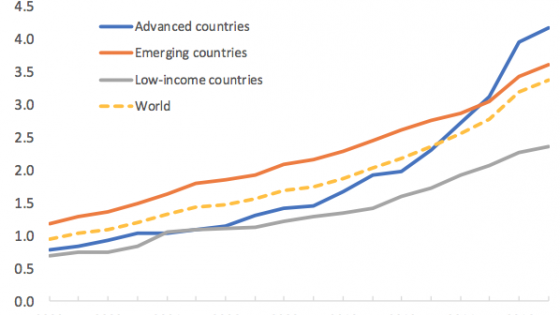First posted on:
Thorsten Beck's "Finance: Research, Policy and Anecdotes" blog, 21 September 2018.
A lot has been written about the Global Crisis —what we have learned, what we have not learned, how we can avoid future crises, and so on. Instead of adding yet another view, which might not look too different from others, let me offer some personal observations —admittedly, in many instances it took some time to put some sense to these observations, but in hindsight we are always smarter.
During my nine years post-PhD at the World Bank I primarily worked on developing country issues, ranging from more developed systems such as Brazil, over transition economies, such as Russia, to low-income countries, such as Bolivia, Kenya and Uganda. I worked on development and stability issues and among the latter, the design of deposit insurance and bank resolution regimes always featured prominently (you will see the relevance of this below).
My first encounter with the Global Crisis was in summer 2007, which I spent with my family vacationing in Germany. Reading German newspapers, I could not avoid the impression that the crisis had started in Germany rather than in the US. Repackaged US subprime mortgages had shown up in the balance sheets of several German banks, including IKB, which was bailed out by other banks and the governments. As we found out later, this was a sign of worse things to come. It also showed the global nature of the crisis to come.
I arrived in the Netherlands to take up my position at Tilburg University in late summer 2008, just in time to witness the onset of the crisis. What Lehman Brothers was for the US (and the global financial system), the Fortis/ABN Amro failure was for the Netherlands (and neighbouring Belgium). My first question for my new colleagues was: how does the bank resolution work in the Netherlands? I got rather funny looks; as I found out quickly, none of the European countries had a bank resolution framework, leaving regulators and governments with a choice between long-winded corporate insolvency proceedings (and the turmoil this causes as shown by Lehman Brothers) and bailout —the path chosen by almost all governments for almost all banks in 2008/9.
The European Commission allowed the bailouts of banks across the EU in spite of the prohibition of state aid for fear of a financial meltdown. In 2009/10 I worked with Diane Coyle, Matias Dewatripont, Xavier Freixas, and Paul Seabright on a report for DG Competition assessing the state aid provided during the Global Crisis across Europe, later published as CEPR book. Our conclusion was that the carrot-and-stick approach advocated by many European policymakers (allow bailout first, punish banks later) did not make much sense as punishing bailed-out banks would reduce competition and not help European banking systems support economic recovery. We recommended focusing instead on regulatory reform to avoid a bailout having to happen again, including putting more burden on junior bondholders and expanding the regulatory perimeter to bank-like financial intermediaries. As always, our recommendations were partially implemented (I think even that could be celebrated as success) —there was a somewhat less aggressive approach by the European Commission towards post-bailout conditions and there was an overhaul of the resolution framework towards bail-in (of course, we were far from the only ones to advocate that!).
This leads me to two of the immediate lessons from the failure of (cross-border) banks in Europe: the need to create bank resolution frameworks and the need to create institutional frameworks to coordinate supervision and resolution in the EU. In the following few years, I actively participated in the policy discussion of what later was named banking union. In 2011, Franklin Allen, Elena Carletti, Philip Lane, Dirk Schoenmaker, Wolf Wagner and I published a policy report on the future of cross-border banking in Europe —among other things, we recommended that EU policymakers create a European-level deposit insurance fund and resolution framework.
I still remember a conference at the BIS in Basel in 2009 where I suggested that the euro area would eventually have to move towards a European version of the FDIC, i.e. a supranational financial safety net. A Fed economist in the audience burst into laughter, declaring that European governments would never agree to this. Lawyers explained to us economists that a treaty change would be necessary to construct such a supranational framework. A few years and zero treaty changes later, the Single Supervisory Mechanism and the Single Resolution Mechanism were established, a strong entry into the banking union and thus a euro area-wide financial safety net. It is far from complete, as many of us economists have reminded policymakers over and over again, and one can argue that the glass is half empty —looking back to 2008/9, however, the glass is certainly half full.
Another important and justified question after the crisis was what the role of the financial sector should be going forward. Was the crisis really proof that financial development does not help growth and that the finance-growth literature had just been proven wrong, as academics and policymakers alike kept telling me? Or is it instead the definition of financial development that causes this discordance? There was certainly a realisation after the Global Crisis that the financial centre approach to financial sector policies might give some growth benefits but also sharper drops during a crisis. Several countries, including the Netherlands, Cyprus and Iceland, had tried this approach, albeit in different ways, but all with other negative outcomes. This was confirmed in aresearch paper by Hans Degryse, Christiane Kneer and myself even for a cross-country sample before the crisis —short-term growth benefits, longer-term high volatility costs of large financial centres. The positive role of the financial sector in the growth process comes from the intermediation and risk management role, not necessarily from having large balance sheet and employing lots of people.
So, how far have we come? Martin Wolf recently wrote that little has changed. And even though many statistics indicate indeed that the world has gone back to business as usual, I beg to differ. Yes, there was no revolution. We did not hang the bankers from the lamp posts and the financial sector has not been completely transformed. But there have been critical changes in the regulatory framework: a much tighter regime of capital requirement, augmented by liquidity requirements (with capital requirements not sufficiently high, as many economists, including this one, would argue, though I am not convinced we should move to 25%); the introduction of macroprudential tools; the introduction of bank resolution frameworks in Europe; a start on the banking union; ring-fencing in the UK (maybe a good example for other countries); and so on. However, there are challenges for regulators, as Elena Carletti, Itay Goldstein and I wrote in a survey: the tension between complexity and simplicity of regulation, where the former allows for better pricing of risks, while the latter avoids regulatory arbitrage; the need for an even stronger focus on systemic risk and macroprudential tools; the need to further finetune resolution frameworks; and the need to adjust the regulatory perimeter as financial service providers might try to take intermediation business out of the costly regulated sector into the unregulated sphere of finance, an ongoing challenge given the rising importance of lending platforms and ‘bigtech’ companies such as Alibaba and Paypal moving into financial service provision.
Does this regulatory progress mean that the financial system is safe? Yes and no! It is safer than it was in 2007 and if a similar shock hit today, everyone would be better prepared. The problem with regulatory reform, however, is that it is always designed to address the previous but not the next crisis. Future fragility will come from other areas, which are —as of now—unknown. Will it be fintech and cybercrime? Will it be different asset classes (student loans in the US, car loans in the UK)? Will it be in emerging markets and triggered by exchange rate movements and rising interest rates in the US? Will it be political shocks to sovereign debt in the euro area? There are many possible sources of fragility across the globe. Economists have not a good track record in forecasting, so I will not participate in this guessing game.
In summary, the past ten years have seen lots of progress in regulatory reforms. What is missing is a more fundamental rethink of the role of the financial sector, especially in high-income countries, at least among policymakers. And while there has been deleveraging in some countries and some sectors, there has been more leveraging in others (partly driven by very loose monetary policies for almost a decade). So, while we might be better prepared for the next financial hurricane, the damage will still be significant! And it is important to not pretend the impossible —the new bail-in framework will not avoid government support in all circumstances. Yes, there will be systemic crises in the future and there will have to be government support.



